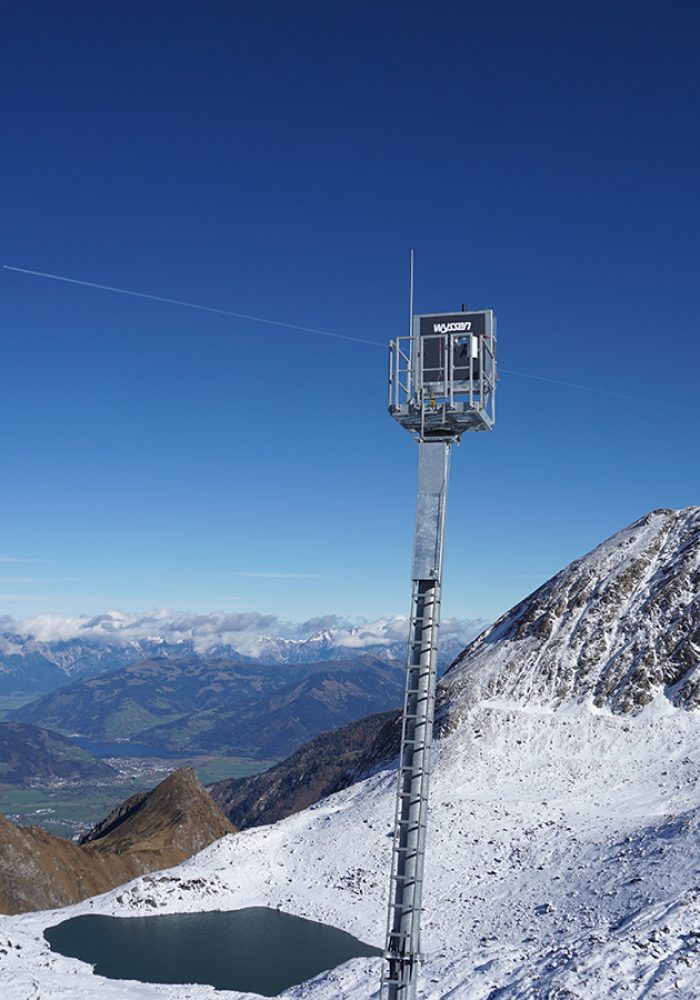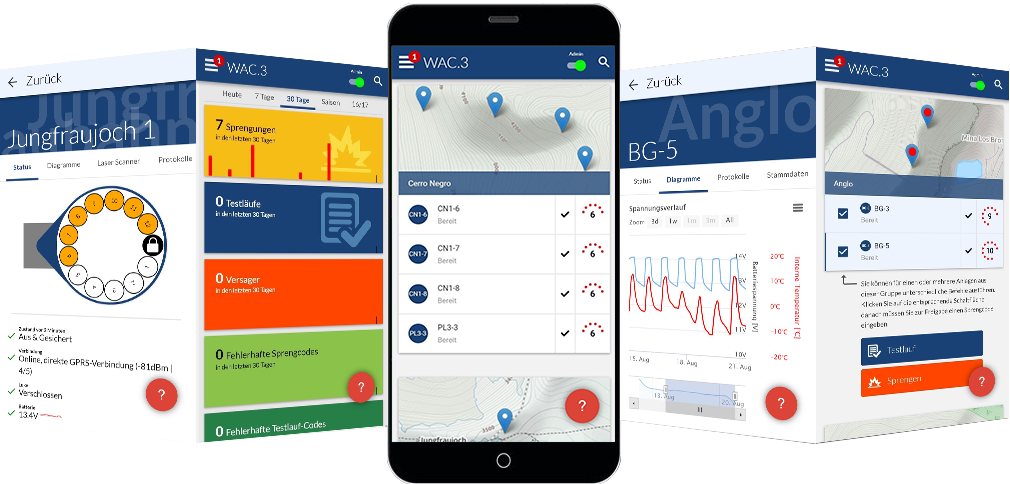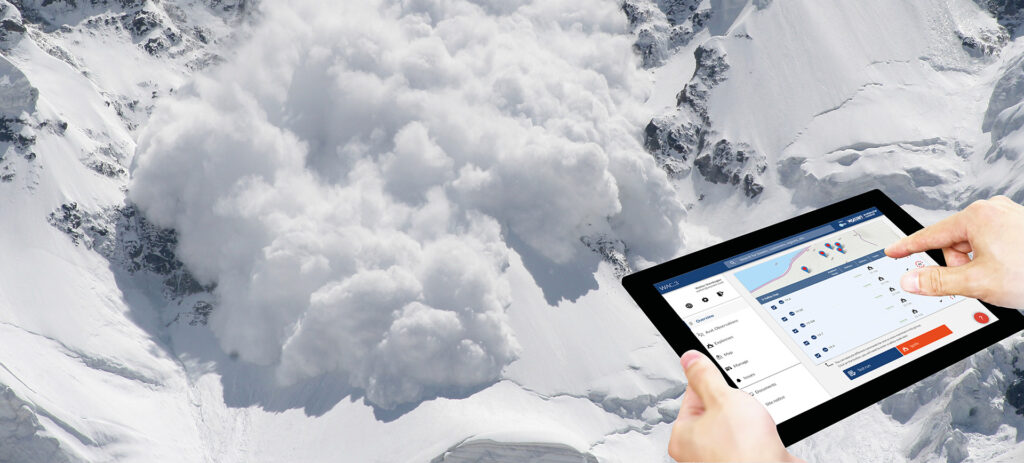Wyssen Mini Avalanche Tower LS6-5
Set up and function
- Operation is being done via the Wyssen Avalanche Control Center WAC.3®
- The mini tower is placed in the avalanche starting zone
- Up to 6 charges can be loaded at 4-5kg (9-11 lbs) of explosive each
- Reloading is being carried out manually over the ladder on the mast
- Power supply is provided by batteries supplied by solar panels

- For the deployment a charge is being dropped out of the deployment box
- During the free fall of the charge a double ignition is activated
- The charge detonates hanging on a cord above the snow cover after a time delay
- The charge height is adjustable when the charges are prepared and loaded
Deployment box
The deployment box is permanently mounted on the mast of the mini tower. Solar panels are installed at the deployment box as well as the antenna. Inside the box sealed from the elements is the deployment mechanism, electronic control and the prepared explosive charges. Thanks to the smart concept highest reliability is guaranteed.
Charge Containers
The explosive charge consists of two orange half-shells with pre-mounted pull activated percussion igniters with slow fuse, which are assembled with 4-5 kg (9-11 lbs) of explosives. The charges are assembled by the operator on-site. Explosives and other pyrotechnical elements are purchased directly by customers from the appropriate suppliers. The plastic is made of biodegradable material.
Advantages
- Air blast with a big charge (effective range of up to 260 m (850 ft) in diameter)
- Simple and low priced alternative to the Wyssen Avalanche Tower LS12-5 and LS24-5
- Operation via WAC.3® just as the Wyssen Avalanche Tower LS12-5, LS24-5 and other systems
- Remote control permits rapid and weather-independent release
- No personnel in danger area
Effectiveness
Practitioners have found that the greatest degree of success for controlled release of avalanches is achieved by a remote-controlled detonation of an effective explosive at the right time and in the right place.
From the avalanche operator’s point of view, a blasting installation must be extremely reliable and effective as well as simple to operate and maintain. The installation in the terrain must be straightforward and the interference of the installation must have minimal impact on sensitive mountain environments. The Wyssen Mini Avalanche Tower is ideal for fulfilling these requirements.
Smallest residual risk thanks to the largest effective range
- Blasting above the snow with bigger charges (4-5kg /9-11lbs) gives the maximum effective range up to 260m in diameter (850 ft)
- Explosives with high detonation speeds produce N-shaped pressure waves which have been proven to cause the best release effect, particularly at a greater distance from the detonation point
- Positioning a tower on a prominent terrain feature and including a 12m (39 ft) tower instead of 10m (33 ft) enables the effect to be reached in locations of pressure shadow (in couloirs, behind terrain ribs)
- Releasing smaller quantities of snow in increments, decreasing possibility for larger avalanches
- Very good stability test for assessment of the local avalanche danger
Highest cost-effectiveness
- Low investment and operating cost in comparison with permanent protective measures (snow sheds, bridges, tunnels)
- Lowest operational costs thanks to its ingenious system concept
- Damage to infrastructure is avoided by the release of smaller portions
- Economic benefits thanks to reduced closure times
Highest reliability
- No critical or moving parts are exposed to the weather
- Solar power supply or wind generator avoids the necessity of vulnerable supply lines in the terrain
- Annual maintenance ensures maximum reliability
Highest degree of safety for the operating staff
- Preparation of the charges takes place in protected areas
Reduced closure times thanks to rapid release, around the clock and in all weathers
- Remote-controlled installations allow operation around the clock
- Very rapid operation possible
- Short closure times
- Less time snow plowing as avalanches are released in smaller portions
Environmental stewardship
- Foundation Footprint is only 1m2
- Short construction times in the terrain simplify planning and implementation
- Blasting over the ground prevents damage to the vegetation cover
- Dismantling after operating life possible without any problems
All in one online platform
The latest software generation includes new hardware for operating, monitoring and data storage of the well-proven Wyssen Avalanche Towers, detection systems and weather stations.


Advantages
- Intuitive web-based operating interface
- Operable from any web-enabled device (Computer, Tablet, Notebook, Smartphone)
- Operation independent of location
- Multiple release from Avalanche Towers possible
- Monitoring of systems 24/7
- Automatic documentation and archiving of activites and system data
- Data transfer via mobile network, radio connection or satellite
Extensive additional features
- ExploDoc
- RiskEval
- ComTool
- HeliTrack
- Weather stations
- 3D snow height measurement via LIA® etc.
Video about operational avalanche control with WAC.3®:

Safety regulations
Personnel
In order to load and operate Wyssen systems, personnel must have attended a certified course by the company and possess a valid certificate for the artificial release of avalanches with explosives. Furthermore, it is very important that the operating staff have the corresponding training and experience for risk assessment, planning of measures, implementation of measures as well being able to assess secondary avalanches and avalanches that could be larger than expected.
Storage
Approval for storing explosives: for each tower location authorisation must be requested by the customer from the responsible authorities for storing explosives in the avalanche tower deployment boxes during the period of operation.
Basic Principles of Controlled Avalanche Release
It is known from practical experience and from the theory of how avalanches arise in deep winter, that the effect of a detonation above the snow cover leads to the best results with respect to residual risk of unpredictable avalanches. The explosive devices used should give a high detonation speed and produce a large volume of gas with a high work factor. Tests with numerous experiments show that explosives with the above-mentioned properties and charging positions above the snow cover give the highest effective ranges. The following table from the WSL Institute for Snow and Avalanche Research SLF Davos Report no. 53/1996 shows the approximate effective ranges for dry new snow of various explosive charge sizes in different positions with respect to the snow surface.
In order to test and to safeguard the avalanche release zone, the whole of the potential release area must be subjected to an additional stress (e.g. by a detonation). This is necessary, because the location of the so-called „hotspots“ (super weaknesses) are not known in advance. An acceptable residual risk after blasting operations is only then reached if these „hotspots“ have been subjected to a sufficiently high additional stress and high strain rates within the snow cover with high speed of deformation (= high detonation speed).
| Height of Detonation Point | Charge Size | Radius of effective range to prevent a natural release | Radius of effective range to prevent a release by a single skier |
|---|---|---|---|
| Blasting above the snow (+3 - 3.5 m) | 4 - 5 kg | 120 - 130 m | 70 m |
| Blasting above the snow (+2 - 2.5 m) | 1.5 - 2.5 kg | 80 - 90 m | 50 m |
| Blasting above the snow (approx. +1 m) | 4 - 5 kg | 80 - 90 m | 50 m |
| Blasting above the snow (approx. +1 m) | 1.5 - 2.5 kg | 60 - 70 m | 35 - 40 m |
| Surface blasting | 4 - 5 kg | 50 - 60 m | 30 - 35 m |
| Surface blasting | 1.5 - 2.5 kg | 35 - 40 m | 20 - 25 m |
| Blasting in snow (approx. -0.2 m) | 4 - 5 kg | 40 m | 25 m |
| Blasting in snow (approx. -0.2 m) | 1.5 - 2.5 kg | 25 m | 15 m |
| Blasting in snow (-0.7 m) | 1.5 - 5 kg | 10 m | 5 - 10 m |
| Mortar 12 cm (0 m) | 3 kg | 40 m | – |
| RPG 8.3 cm (0 m) | 0.7 kg | 20 - 25 m | 10 - 15 m |
| Mortar 8.1 cm (0 m) | 0.6 kg | 15 - 20 m | 10 m |
Source of the table: SLF Davos Report No. 53/1996
Note for our registered trademarks ®: > Link to impressum
Mini avalanche tower
Mini avalanche tower Mini avalanche tower Mini avalanche tower